#anishinaabe artist
Photo

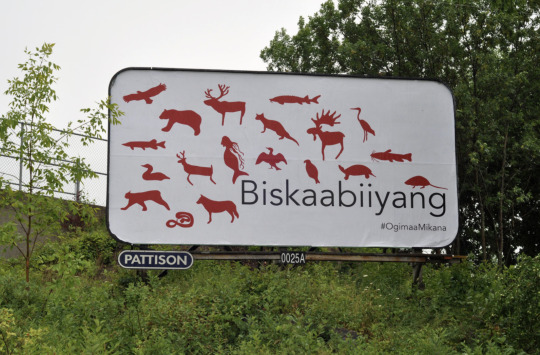


Ogimaa Mikana. Don’t be shy to speak Anishinaabemowin when it’s time. Bayfield St., Barrie, Ontario; Biskaabiiyang. North Bay, Ontario; Untitled (All Walls Crumble). Ottawa, Ontario; Anishinaabe manoomin inaakonigewin gosha. Peterborough, Ontario.
Ogimaa Mikana is an artist collective founded by Susan Blight (Anishinaabe, Couchiching) and Hayden King (Anishinaabe, Gchi’mnissing) in January 2013. Through public art, site-specific intervention, and social practice, we assert Anishinaabe self-determination on the land and in the public sphere.
The Ogimaa Mikana Project is an effort to restore Anishinaabemowin place-names to the streets, avenues, roads, paths, and trails of Gichi Kiiwenging (Toronto) - transforming a landscape that often obscures or makes invisible the presence of Indigenous peoples. Starting with a small section of Queen St., re-naming it Ogimaa Mikana (Leader's Trail) in tribute to all the strong women leaders of the Idle No More movement, the project hopes to expand throughout downtown and beyond.
“The Anishinaabeg endure. We do so through settler colonial time, and across space. We do so in contention. Untitled (All Walls Crumble) considers this movement. To be Indigenous in the city is so often a struggle for recognition, to be seen, and to resist the erasure that is common in Toronto, Montreal, Ottawa, etc. Yet with recognition also comes appropriation and co-optation. In this unease, we consider the benefits of erasure, or at least, covert movement.
Inspired by stories of our relatives and ancestors counting coup, and Basil Johnson’s description of warfare more generally, the Ogimaa Mikana Project considers the tension between visibility and invisibility to challenge settler colonial logic. Against a crumbling wall holding up Ottawa’s major highway - scheduled for demolition and replacement - we draw attention to the ways the settler state recycles itself, and by extension, affirms its legitimacy. We see it and resist in provocative ways that mirror a there/not there presence.
Against this crumbling wall, we reclaim space for an anti-recognition: to speak to each other, as Anishinaabeg, as communities pushed out by gentrification, as the colonized, and offer a refrain and a sign of defiance: “Wakayakoniganag da pangishin. Nin d'akiminan kagige oga ahindanize.”
#Ogimaa Mikana#susan blight#Hayden King#anishinaabeg#anishinaabe#Anishinaabe artist#anishinaabeg artists#Anishinaabe Art#indigenous art#INDIGENOUS CONTEMPORARY ART#contemporary art#public art#place-naming#intervention#art intervention#contemporary anishinaabe art#indigenous collective#indigenous artist collective#Anishinaabemowin
855 notes
·
View notes
Text
More art of Nanabozho bc he is so silly and scrimblo!~

A doobius little creature getting up to mischief
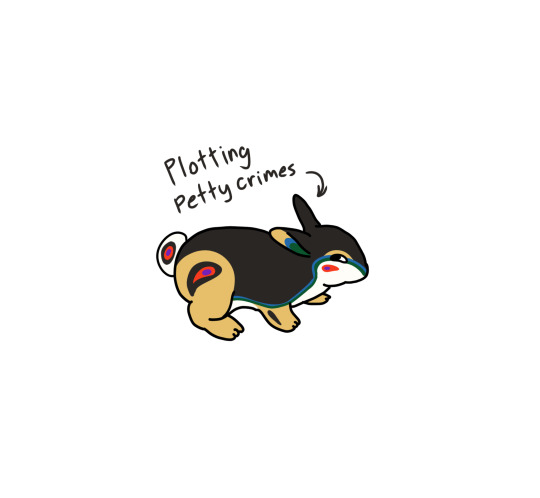
#art#digital art#nanaboozhoo#nanabush#nanabozho#wenabozho#anishinaabe#anishinaabeg#anishinaabe art#anishinaabe artist#ojibwe art#ojibwe#ojibway#ojibwa#first nations#native american#native#indigenous#indigenous art#indigenous artist#furry#furrydrawing#furry community#furry art#rabbit
38 notes
·
View notes
Text
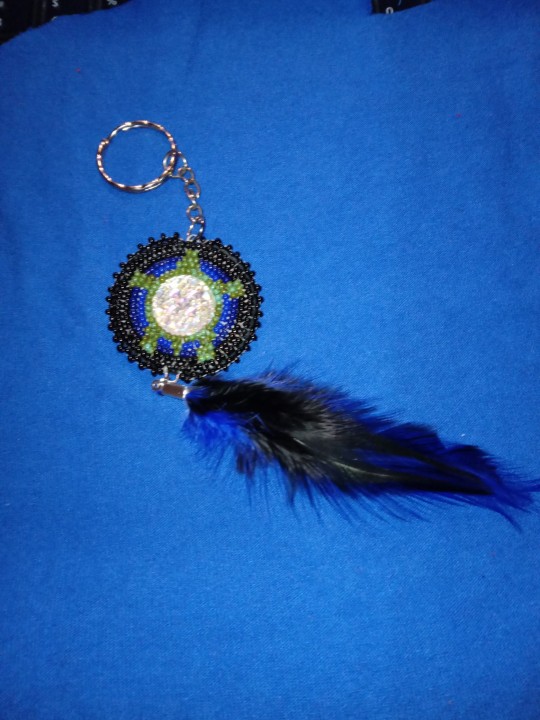
Oh my gosh, look at what one of my students made me as a thank you give for the end of our term! It's so gorgeous!
Check out her stock, everything is absolutely beautiful!
11 notes
·
View notes
Text

Article Link
"Minnetonka first started selling its “Thunderbird” moccasins in 1965. Now, for the first time, they’ve been redesigned by a Native American designer.
It’s one step in the company’s larger work to deal with its history of cultural appropriation. The Minneapolis-based company launched in the 1940s as a small business making souvenirs for roadside gift shops in the region—including Native American-inspired moccasins, though the business wasn’t started or run by Native Americans. The moccasins soon became its biggest seller.

[Photo: Minnetonka]
Adrienne Benjamin, an Anishanaabe artist and community activist who became the company’s “reconciliation advisor,” was initially reluctant when a tribal elder approached her about meeting with the company. Other activists had dismissed the idea that the company would do the work to truly transform. But Benjamin agreed to the meeting, and the conversation convinced her to move forward.
“I sensed a genuine commitment to positive change,” she says. “They had really done their homework as far as understanding and acknowledging the wrong and the appropriation. I think they knew for a long time that things needed to get better, and they just weren’t sure what a first step was.”

Pictured: Lucie Skjefte and son Animikii [Photo: Minnetonka]
In 2020, Minnetonka publicly apologized “for having benefited from selling Native-inspired designs without directly honoring Native culture or communities.” It also said that it was actively recruiting Native Americans to work at the company, reexamining its branding, looking for Native-owned businesses to partner with, continuing to support Native American nonprofits, and that it planned to collaborate with Native American artists and designers.
Benjamin partnered with the company on the first collaboration, a collection of hand-beaded hats, and then recruited the Minneapolis-based designer Lucie Skjefte, a citizen of the Red Lake Nation, who designed the beadwork for another moccasin style and a pair of slippers for the brand. Skjefte says that she felt comfortable working with the company knowing that it had already done work with Benjamin on reconciliation. And she wasn’t a stranger to the brand. “Our grandmothers and our mothers would always look for moccasins in a clutch kind of situation where they didn’t have a pair ready and available to make on their own—then they would buy Minnetonka mocs and walk into a traditional pow wow and wear them,” she says. Her mother, she says, who passed away in 2019, would have been “immensely proud” that Skjefte’s design work was part of the moccasins—and on the new version of the Thunderbird moccasin, one of the company’s top-selling styles.
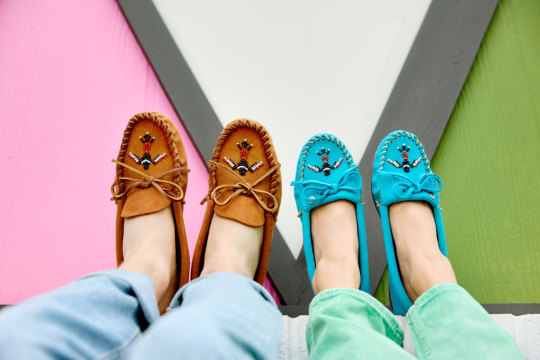
[Photo: Minnetonka]
“I started thinking about all of those stories, and what resonated with me visually,” Skjefte says. The redesign, she says, is much more detailed and authentic than the previous version. “Through the redesign and beading process, we are actively reclaiming and reconnecting our Animikii or Thunderbird motif with its Indigenous roots,” she says. Skjefte will earn royalties for the design, and Minnetonka will also separately donate a portion of the sale of each shoe to Mni Sota Fund, a nonprofit that helps Native Americans in Minnesota get training and capital for home ownership and entrepreneurship.
Some companies go a step farther—Manitobah Mukluks, based in Canada, has an Indigenous founder and more than half Indigenous staff. (While Minnetonka is actively recruiting more Native American workers, the company says that employees self-report race and it can’t share any data about its current number of Indigenous employees.) Beyond its own line of products, Manitobah also has an online Indigenous Market that features artists who earn 100% of the profit for their work.
White Bear Moccasins, a Native-owned-and-made brand in Montana, makes moccasins from bison hide. Each custom pair can take six to eight hours to make; the shoes cost hundreds of dollars, though they can also be repaired and last as long as a lifetime, says owner Shauna White Bear. In interviews, White Bear has said that she wants “to take our craft back,” from companies like Minnetonka. But she also told Fast Company that she doesn’t think that Minnetonka, as a family-owned business, should have to lose its livelihood now and stop making moccasins.
The situation is arguably different for other fashion brands that might use a Native American symbol—or rip off a Native American design completely—on a single product that could easily be taken off the market. Benjamin says that she has also worked with other companies that have discontinued products.
She sees five steps in the process of reconciliation. First, the person or company who did wrong has to acknowledge the wrong. Then they need to publicly apologize, begin to change behavior, start to rebuild trust, and then, eventually, the wronged party might take the step of forgiveness. Right now, she says, Minnetonka is in the third phase of behavior change. The brand plans to continue to collaborate with Native American designers.
The company can be an example to others on how to listen and build true relationships, Benjamin says. “I think that’s the only way that these relationships are going to get any better—people have to sit down and talk about it,” she says. “People have to be real. People have to apologize. They have to want to reconcile with people.”
The leadership at Minnetonka can also be allies in pushing other companies to do better. “My voice is important at the table as an Indigenous woman,” Benjamin says. “Lucie’s voice is important. But at tables where there’s a majority of people that aren’t Indigenous, sometimes those allies’ voices are more powerful in those spaces, because that means that they’ve signed on to what we’re saying. The power has signed on to moving forward and we agree with ‘Yes, this was wrong.’ That’s the stuff that’s going to change [things] right there.”"
-via FastCompany, February 7, 2024
#indigenous#indigenous artists#indigenous art#moccasins#thunderbird#native american#native american art#cultural appropriation#indigenous peoples#cultural representation#minnesota#minnetonka#minneapolis#red lake nation#ojibwe#anishinaabe#reconciliation#fashion#fashion news#good news#hope#indigenous designers#native artist#indigenous artist
1K notes
·
View notes
Text

Native land in native hands
1K notes
·
View notes
Text
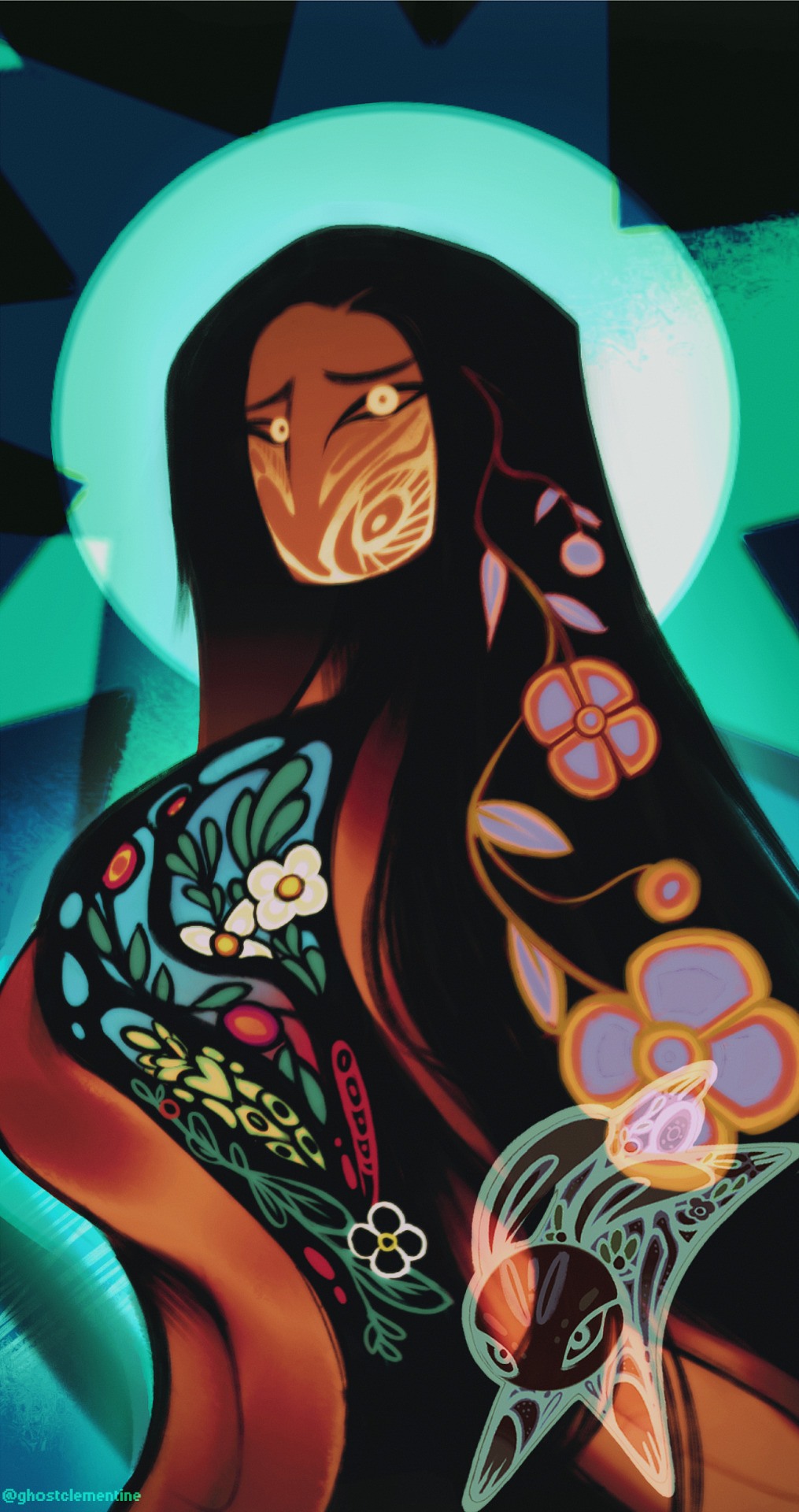
🐇👻 jiibayaabooz 👻🐇
• nanabozho beloved little brother who looks after the spirits in the spirit world.
(2021)
#my art#ghostclementine art#digital art#artists on tumblr#art#digital drawing#digital artist#anishinaabe#indigenous#indigenous art#indigenous artist#indigenovember#native artist#native art#ndn art#rabbit#bunny#spirit#beadwork#ojibwe#saulteaux#woodlands style
285 notes
·
View notes
Text

[Image Description: a digital drawing of Cecil Palmer from Welcome to Nightvale. Cecil is a Native American man with tanned skin and long white hair parted on the right side. He is wearing heart-shaped sunglasses that are reflecting the desert sunset, and a brown jacket over a button-up shirt. His belt buckle, earrings, and bolo tie are also shaped like hearts. Cecil is depicted from the thighs up in a desert during sunset. The dunes and cacti behind him are entirely in shadow against the colorful, streaked sky. He looks to the right, his hair blown by the wind, as he pulls his jacket closer to his body. End Description.]
Long time followers know I’m a cranky brown woman and one of the things that makes me cranky is the use of American South West aesthetics without homage to the Indigenous and Black Americans and Mexicans that invented the aesthetic.
My Cecil is Native (and your question should be “which tribe?!” But I haven’t decided yet. I’m pondering.) He started going gray when he was a teenager and had fully white hair by the time he was 25.
Also I love how this came out! The sky!! The plants!! The sunglasses B-)
#cecil gershwin palmer#cecil palmer#welcome to night vale#wtnv#fanart#illustration#artist on tumblr#art#If you voted in the poll for John Gaius or Cecil Palmer from a million years ago: you are legally obligated to reblog this#((this tag is for the mutuals: I totally recycled this from an OC Bimázakonenjige design))#Bim#((Who is Anishinaabe))#But he looks good in the southwest#I do love southwest aesthetic and gotta draw more rezzy southwest OCs
103 notes
·
View notes
Text
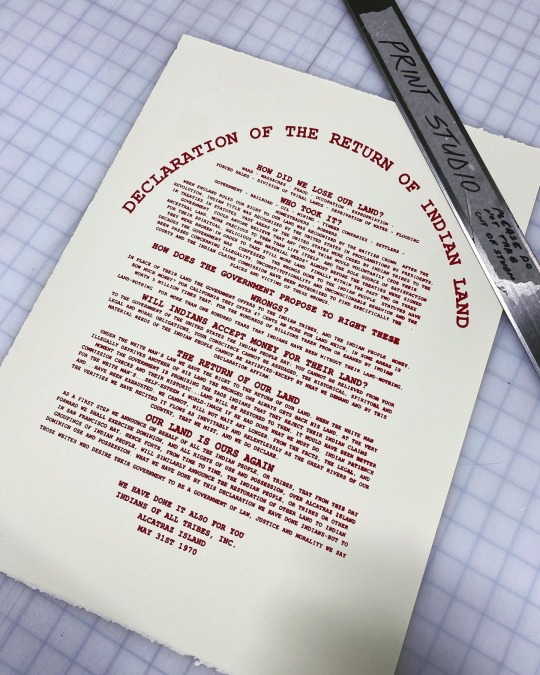
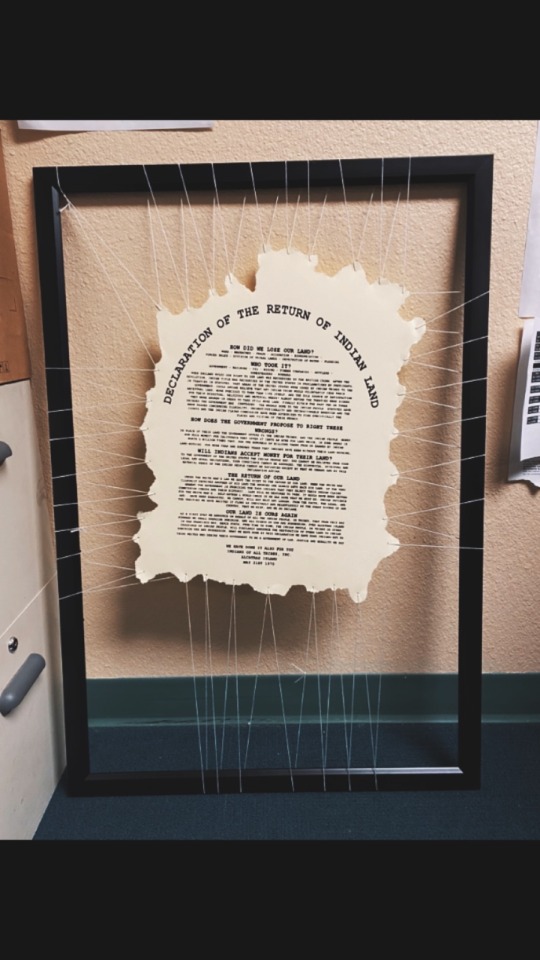
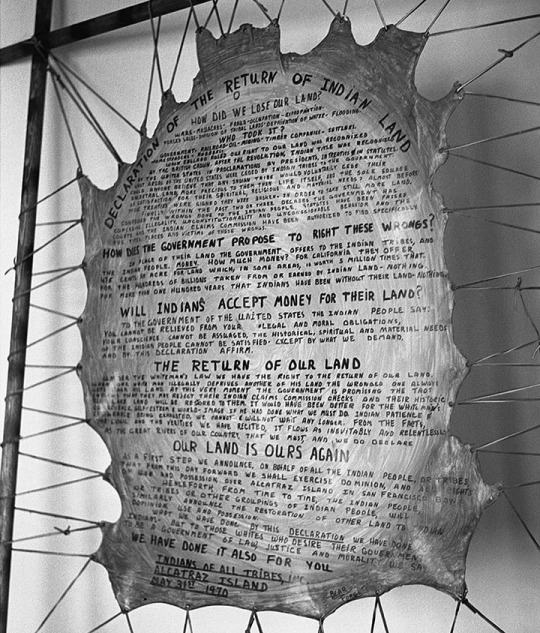
“Declaration of the Return of Indian Land”
Ryan Young
2023
Silkscreen print on paper, string, frame
Back in the printmaking studio for the first time in 4 1/2 years
#screen printing#native american#indigenous#ryan young#native#art#ojibwe#queer#two spirit#anishinaabe#artist#2 spirit
258 notes
·
View notes
Text
This is a longshot but does anyone know of any Native-owned shops that sell embroidery patterns? Not finished embroidery pieces, patterns that can be printed on things like water soluble fabric.
I really want some cultural pieces to hang around my house but I'm not much of an artist myself and I know that the vast majority of shops I find from googling are gonna be owned by some random white woman who's also selling sweetgrass at $30/braid.
#i might do the anishinaabe flag#or a medicine wheel#but i'd really like to be able to support some native business owners and artists#okay to reblog
51 notes
·
View notes
Text

Read this story in the Winnipeg Free Press (by Niigan Sinclair) the other day and felt compelled to put it in my Techo, adding some drawings.
7 notes
·
View notes
Text
youtube
#art#leanne betasamosake simpson#under your always light#art student#art school#artist#indigenous artists#anishinaabe artists#Youtube
4 notes
·
View notes
Photo

Blake Angeconeb | The Kiss (Gustav Klimt) but Indigenous. 2022
Blake Angeconeb is an Anishinaabe woodlands artist who hails from Treaty 3 territory. His first venture into art began 6 years ago during a fun painting session with his younger niece, which has since launched him into a full-time career as an artist. Blake’s primary practice involves acrylics and multimedia on canvas, blending the school of woodlands art with pop culture references. Blake is a self-trained painter with a growing collection of small and large scale works who enjoys collaborating with other artists. He is part of the Caribou clan and a proud member of Lac Seul First Nation.
#Blake Angeconeb#gustav klimt#The Kiss#Indigenous art#INDIGENOUS CONTEMPORARY ART#contemporary art#woodlands art#contemporary woodlands art#Anishinaabe Art#Anishinaabe artist#anishinaabe contemporary art#digital art#indigenous digital art#contemporary digital art
203 notes
·
View notes
Text

Caroline Monnet, Juno I, 2017, Hair, Tar, Oil Paint
#Caroline monnet#art#contemporary art#artist#contemporary artist#canadian art#installation#installation art#indigenous#indigenous art#indigenous artist#algonquin#algonquin artist#anishinaabe
26 notes
·
View notes
Text
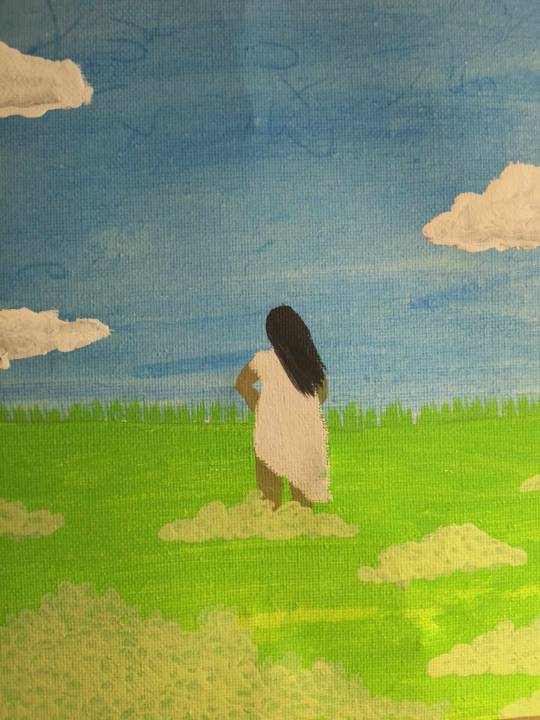
''Belonging'' by Halle Ward
mizhishawabi: [s]he sits out in the open
naawashkosiw: in the middle of a meadow
#indigenous heritage#indigenous#anishinaabe#métis art#mixed#native#native artist#indigenous art#painting#anishinaabemowin#ojibwe#indigenous languages
5 notes
·
View notes
Text

#doodle#artists on tumbler#markers suck but it is all I had#traditional art#residential schools#rcmp#nun#small illustration#markers#my art#contemporary art#ojibwe art#anishinaabe#old art#need to post something at least
3 notes
·
View notes
Text

🍂🍁 𝙄𝙣𝙞𝙣𝙖𝙖𝙩𝙞𝙜 𝙟𝙞𝙞𝙗𝙖𝙮 🍁🍂
"𝘴𝘱𝘪𝘳𝘪𝘵 𝘮𝘢𝘱𝘭𝘦 𝘵𝘳𝘦𝘦"
(2022)
#my art#ghostclementine art#digital art#artists on tumblr#art#digital drawing#digital artist#indigenous art#anishinaabe#indigenous artist#native artist#native art#ndn art#fall#spirit#maple#maple tree#autumn#fall aesthetic#background art#landscape painting
92 notes
·
View notes